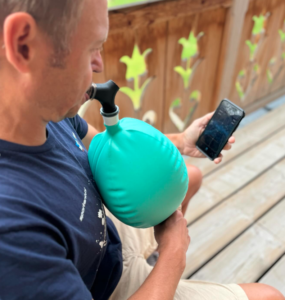
When it comes to elite CrossFit athletes, few names have commanded as much respect and admiration as Sara Sigmundsdóttir. Known for her fierce determination, powerful engine, and comeback resilience, Sara has been a podium threat at the CrossFit Games and a crowd favorite for years. And now, she’s turning heads once again — not just with her performance, but with her preparation. This is how to Increase lung volume with respiratory muscle training for CrossFit.
Sara has recently been spotted training with the Isocapnic BWB respiratory training device — a powerful tool designed to develop lung volume, breathing strength, and respiratory endurance. For a sport as demanding and varied as CrossFit, it’s no surprise that Sara is looking for every possible edge. But there’s more to this story — behind the scenes is coach Kyle Ruth of Training Think Tank, a rising authority in the world of respiratory performance.
Kyle Ruth: Breathing New Life Into CrossFit Performance
Kyle Ruth has been quietly but confidently carving out a name for himself as one of the world’s foremost experts on respiratory muscle training for CrossFit athletes. Through his work at Training Think Tank, he’s developed a reputation for being science-forward, athlete-focused, and always in pursuit of untapped potential. His methods blend physiological testing, data-informed program design, and innovative tools like the Isocapnic BWB — all tailored to the unique metabolic chaos of CrossFit.
The inclusion of Isocapnic training in his protocols isn’t a gimmick — it’s a deliberate, strategic move to improve performance at the most foundational level: respiration.
Why Respiratory Muscle Training Matters in CrossFit
CrossFit athletes often face one of the most underestimated limitations in sport — the respiratory system. When the lungs can’t keep up, neither can the legs or the brain. That feeling of redlining halfway through a workout? It’s not always muscle fatigue — often it’s respiratory fatigue.
The Isocapnic BWB solves this by allowing athletes to train their breathing muscles — the diaphragm, intercostals, and accessory breathing musculature — without the risk of over-breathing and CO₂ imbalance. Through guided protocols, it helps athletes:
- Expand lung volume — making each breath more efficient.
- Build inspiratory and expiratory strength — so breathing feels easier, even under heavy fatigue.
- Improve respiratory endurance — enabling athletes to sustain higher outputs for longer.
And for CrossFitters like Sara, who must transition rapidly between strength, gymnastics, and conditioning efforts, the ability to breathe better can be the difference between podium and pack.
Sara’s Career: The Engine Behind the Fire
Sara burst onto the CrossFit scene in 2015, instantly establishing herself as one of the sport’s most exciting athletes. With two third-place finishes at the CrossFit Games and multiple Open and Regional wins, she’s been a top-tier competitor for nearly a decade. But her journey hasn’t been without setbacks — injuries have tested her resolve, and comebacks have become part of her story.
Now, as she evolves her training approach, it’s no surprise she’s leaning into the nuances of preparation — including the breathwork that underpins it all.
Try These Two BWB Workouts for CrossFitters
If you’re inspired by Sara’s example and ready to integrate respiratory training into your CrossFit routine, here are two powerful ways to begin — both featured in the Isocapnic app:
Session 1: The Perfect Pre-Training Warm-Up (Free in the App)
This warm-up is designed to open up your breathing range, improve lung elasticity, and get your respiratory system primed for high-intensity work.
- Start at 15 breaths per minute
- Build gradually over 5 minutes to 40 breaths per minute
- Focus on breathing as much volume of air as you can per breath
- Visualize stretching your lungs and expanding your breathing range
- Use this before your WOD or strength work to activate your breathing system without fatigue
Check out the app HERE
Session 2: Isocapnic AMRAP – Breathing-Enhanced Intervals
This training session pairs high-intensity functional work with active respiratory recovery, helping you develop both performance and resilience.
6 Rounds (Work: Isocapnic Active Rest Intervals)
4-minute AMRAP:
- 10 Wall Balls (20/14 lb)
- 10 Box Jump Overs (24″/20″)
- 10/8 Cal Row or Echo Bike
Active Rest:
- 2 minutes on the BWB at 25 breaths per minute between each round
This session teaches your body to recover while still breathing under control — a skill that pays off in competition and chaos alike. This is definitely how to increase lung volume with respiratory muscle training for CrossFit.
Breathe Like a Champion
Sara’s decision to add the Isocapnic BWB to her training stack signals a broader trend: elite athletes are recognizing that breathing isn’t just automatic — it’s trainable. And with thought leaders like Kyle Ruth guiding the way, we’re entering a new era where respiratory capacity becomes a performance metric all its own.
Ready to breathe like a Games athlete? Grab your BWB, download the app, and start building your engine from the inside out.
Follow Sara HERE
Follow Coach Kyle HERE



